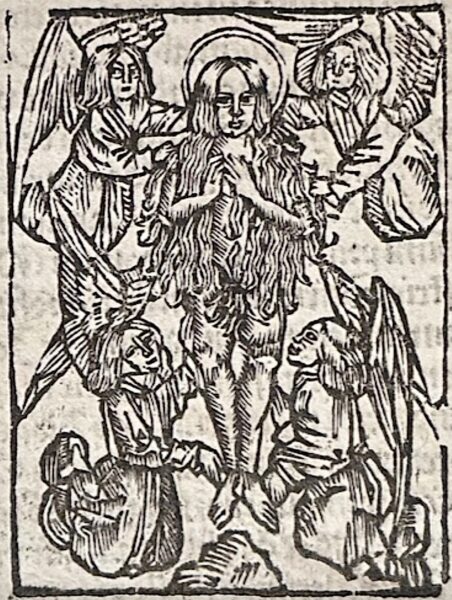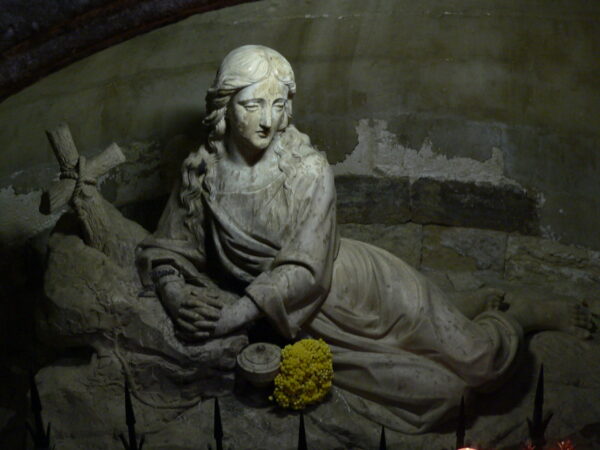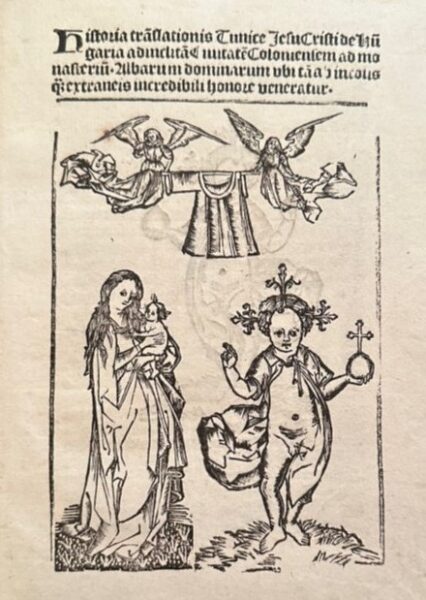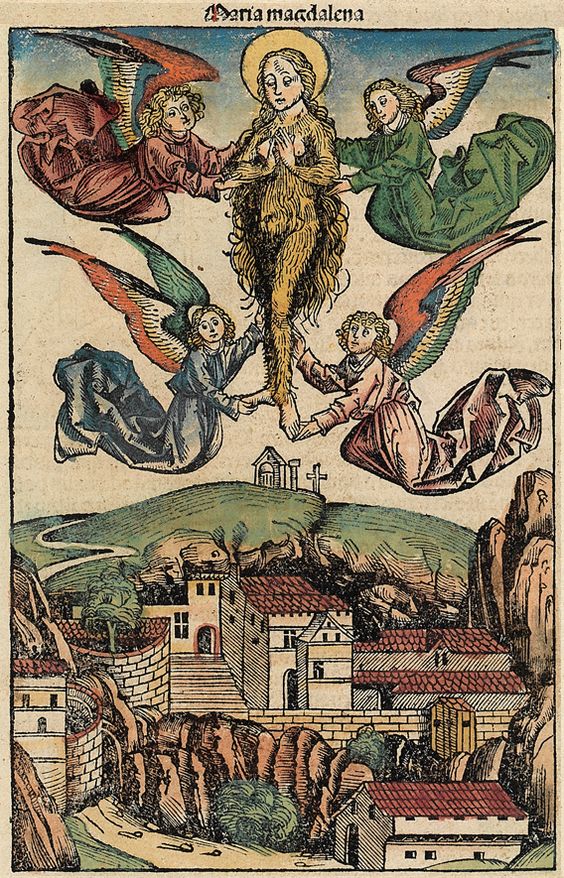
Last updated August 13, 2024
In 2020, I wrote a blog post, Assumption of Hairy Mary, because I was interested in images of Mary Magdalene that I had come across, where she was shown clothed in nothing other than her long red hair. In some images, she is even depicted with a fur-like suit or hair that is growing directly out of her skin. I never suspected that I would revisit that blog post, but I became aware of this recently revealed woodcut image that appears to be a Hairy Mary Magdalene, shown at left, and I became intrigued. So, I am writing this blog post about a rare book that contains this image and that details the story of a relic of the Christ child’s blue tunic.
The legend of the tunic and the woodcut image were passed along to me by Bill Cotter, whose copy of Historia Translationis Tunicae Jesu Christi, a rare 15th century incunabulum, now held at the Library of Congress, tells the story of the Christ child’s tunic. An incunabulum is a book, pamphlet, or flyer that was printed in the early days of the printing press, in the second half of the 15th century. Beginning in 1500 CE, printing was more widely available, with an estimated 1000 printing presses operating in Western Europe at the time. Incunabula are different than manuscripts, which are hand written documents.
Relics were sort of a thing back in the Middle Ages, and you can still see numerous examples in churches across Europe. Relics, often bone fragments or even whole pieces of the bodies of saints, were carefully displayed in richly decorated reliquaries or kept in other small gilded coffrets/caskets/boxes in crypts below cathedrals. Writings from early church leaders take relics for granted, and it was decreed at the second council of Nicea in 787 that every altar in Christian churches was to contain a relic. You can also find relics in the United States, at the Saint Anthony Chapel in Pennsylvania and at the Maria Stein Shrine of the Holy Relics in Ohio. And there may still be some in the altars of other Catholic churches across the U.S. I remember as a child, in the early 1970s, learning that there was a relic in the altar at St. Agatha’s Catholic Church in Columbus, Ohio.
There were other relics that were not taken from human remains, such as pieces of the cross Jesus was crucified on and the cloth that Veronica used to wipe the face of Jesus. Medieval Europeans who traveled to the Holy Land during the crusades would often bring relics back to their home churches. These became prized objects that fueled the commerce of pilgrimages, bringing visitors and new ideas from far away places to their communities. Saints and relics of saints were not worshipped (God alone is worshipped), but many miracles were attributed to the veneration of relics and the intercession of patron saints, like Mary Magdalene. There are even accounts of rivalries between communities over the relics of saints and some theft of such items. For example, in 1087, the relics of Saint Nicholas were stolen from his tomb in Myra by sailors from Bari, who moved them to their Italian seaport that then became an important pilgrimage site.

During the 13th century, there was a determined attempt by the church, in areas that are now France, Italy, and Germany, to convert women who were leading sinful lives [read living in poverty] to Christianity. The bishops gathered them together into communities that had a special devotion to Mary Magdalene. In Germany, especially, these women were put under the jurisdiction of the Dominican Order (also known as Order of Preachers) that was founded in France by a Castilian priest named Dominic de Guzmán in 1216.
In 2007, I visited the basilica dedicated to Mary Magdalene in Saint-Maximin-la-Sainte-Baume, a city located in southern France. Mary Magdalene supposedly lived out the last years of her life as a hermit in le-Sainte-Baume – a cave just outside of town. And a Dominican monastery is known to have been located in Saint Maximin between the years of 1295 and 1790.
Mary Magdalene’s relics are on display at the basilica – her skull, actually! Yes, it’s creepy and strange to our twenty-first century sensibilities, but it was just part of the religious landscape in 1295, when work on the Gothic basilica in Saint Maximin began. Just wiki “Mary Magdalene relics” and you can see a photo there, if you just have to see it. Instead, I include this photograph (from my 2007 trip) of a Mary Magdalene statue from the basilica that is easier on the eyes! See also Reference 3 for an interesting article that describes a reconstruction from over five hundred photographs of the skull that purports to show what Mary Magdalene may have looked like.

Anyway, back to the tunic relic – the story begins in 1474, when Thomas Fremperger, chaplain and physician at the court of the Holy Roman Emperor Frederick III (1415-1493,) traveled to Cologne, in what is now Germany, with Frederick and the Emperor’s fifteen-year-old son, the future Maximilian I. While in the city, they visited the Convent of the Magdalens of the White Sisters, a Dominican monastery founded in 1229. The nuns were called Weisse Frauen (White Sisters), because they wore white habits. At the monastery, the pilgrims were able to see a fabulous relic – the Christ child’s blue tunic, with the left sleeve missing. Fremperger soon thereafter wrote Historia Translationis Tunicae Jesu Christi, a short book that recounts the history of the tunic.
The narrative of the relic itself starts in the middle of the 13th century, when the court chaplain of the Hungarian queen Mária Laszkarisz (circa 1206-1270) began praying fervently for a vision of Christ. God appeared to the chaplain and offered him a choice: he could see Christ in his suffering or Christ as a child. The chaplain felt that the pain of experiencing a vision of Jesus on the cross would be too much to bear, so he chose to see the Christ child, who appeared to him in a great light, dressed in a blue silk tunic. After the vision of Christ vanished, the tunic remained, and the chaplain gave the holy relic to Queen Mária Laszkarisz, who sealed it in a gilded coffret.
In 1262, as the tale continues, a soldier in the service of the Teutonic Knights of Jerusalem, who had fought for the Hungarian king in the war against the Tartars, (erroneously referred to as Turks in Historia Translationis Tunicae Jesu Christi) asked the aging queen for the tunic as payment for his services. He wanted to give it to a nun residing in the monastery of the Magdalens of the White Sisters in Cologne, possibly his sister. The queen agreed, but kept the left sleeve, which eventually became a prized relic at the Dominican Convent on Margaret Island in the river Danube at the center of Budapest.
The tunic was taken to Cologne and given to the nun, but she soon died with the secret of the relic undisclosed. In this way, the tunic, in its beautiful coffret, was forgotten for a century and a half. Then on June 12, 1412, a group of Hungarian pilgrims, who knew the legend, stopped at the Cologne convent on their way to Aachen (another famous pilgrimage site in what is now Germany) and asked to see the tunic. The White Sisters were surprised by this, since they had no knowledge of the tunic. The pilgrims said it had only one sleeve and was stored in a beautiful, gilded box. When the sisters found it, the tunic was placed in a reliquary in the convent for all to see.
Fremperger concluded the manuscript with his eyewitness account of viewing the tunic with Emperor Frederick III, Maximilian, and the royal entourage at the convent in Cologne in 1474. Unfortunately, the tunic was lost when the convent was dissolved in 1802.
Only three handwritten manuscripts of Historia Translationis Tunicae Jesu Christi are known to exist. One is in the Corvina Library, and there are two at the Cologne Historical City Archives. A modern critical edition with facsimiles of the printed text, and of the manuscript pages in the Corvina Library can be viewed on the website for the Hungarian National Library.
There are also about a dozen incunabula documents in European collections and two copies in the United States – Cotter’s copy, now at the Library of Congress, and one that is missing the title page at Princeton University. Cotter notes that the tense of the narrative suggests that Fremperger wrote it sometime shortly after 1474, the date listed in the last sentence of the text. He also cites an analysis of the manuscript’s typeface that indicates a possible Dutch origin, suggesting a tentative print date of around 1500, most likely printed in Cologne by Ludwig von Renchen. In addition, examination of the manuscript revealed a pot watermark in the paper stock that is of Low-Country origin. These observations and others show that many questions regarding the creation and circulation of this manuscript in the Middle Ages still remain.



In terms of artwork, the Translationis Tunicae Jesu Christi manuscript contains five woodcuts, but the identity of the artist is not known. The third woodcut (Image 3 above) shows angels holding the one-sleeved tunic and perhaps bringing it into the world. There is no obviously identifiable source for this image, but its style (particularly in the modeling of the angels’ garments) is similar to the other two title woodcuts. However, the two images below the angels and tunic are almost identical to 15th century prints by Martin Schongauer – “Das Segnende Cristuskind” (circa 1470-90) shown in Image 4 and “The Small Madonna and Child,” (circa 1480) shown in Image 5.
The final somewhat crude woodcut of Mary Magdalene, lifted aloft by four angels (Image 1 above), has some similarities to Michael Wolgemut’s woodcut for the Nuremberg Chronicle (Image 6) that was completed around 1493. However, the wings of the angels in the two woodcuts look siginificantly different, so it is possible that this Hairy Mary image may have been inspired by another unknown artist.
Reference 1: “A Mysterious Imprint, Narrating the Story of a Lost Relic,” W.S. Cotter Rare Books, No. 4620.
Reference 2: Fremperger, Thomas, “Historia Translationis Tunicae Jesu Christi,” Bibliotheca Nationalis Hungariae, circa 1500 CE.
Reference 3: Seidel, Jamie, “Is this Mary Magdalene? Forensic Reconstruction of a Holy Relic Puts a Face to the Skull of a Saint,” The New Zealand Herald, September 16, 2017.
Reference 4: “Convent of the White Women of the Penitential Order of Mary Magdalene,” Monastic Matrix website, University of St. Andrews, UK, 2021.
Reference 5: Koslosky, Philip, “Why do Dominicans Wear a White Habit?” Aleteia website, August 8, 2021.
Image 1: “A Mysterious Imprint, Narrating the Story of a Lost Relic,” W.S. Cotter Rare Books, No. 4620, page 9, used with permission.
Image 2: Statue of Mary Magdalene from Basilica in Saint-Maximin-la-Sainte-Baume, France, photocredit Andy Hong, 2007.
Image 3: “A Mysterious Imprint, Narrating the Story of a Lost Relic,”W.S. Cotter Rare Books, No. 4620, page 4, used with permission.
Image 4: Schongauer, Martin, “The Small Madonna and Child,” circa 1480, accession number 1944.8.38 National Gallery of Art, Washington DC, public domain.
Image 5: Schongauer, Martin, “Das segnende Christuskind (L 31),” Wikimedia Commons, public domain.
Image 6: Illustration from Nuremberg Chronicle, illustrated by Michael Wolgemut and Wilhelm Pleydenwurff, text by Hartmann Schedel, 1493, Wikimedia Commons, public domain.















Leave a Reply
Join the conversation by submitting a comment to this blog post below.